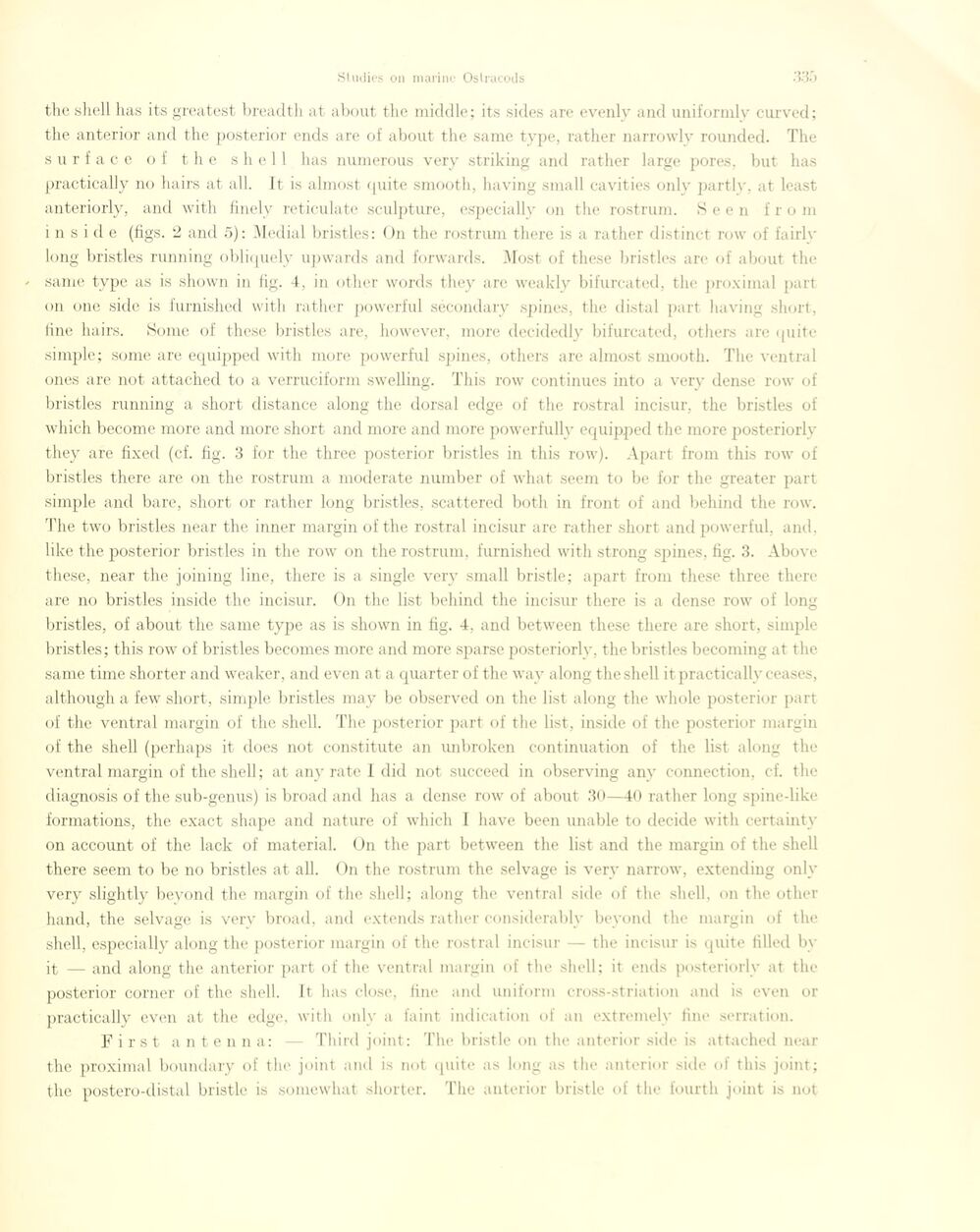
Full resolution (JPEG) - On this page / på denna sida - Sidor ...

<< prev. page << föreg. sida << >> nästa sida >> next page >>
Below is the raw OCR text
from the above scanned image.
Do you see an error? Proofread the page now!
Här nedan syns maskintolkade texten från faksimilbilden ovan.
Ser du något fel? Korrekturläs sidan nu!
This page has never been proofread. / Denna sida har aldrig korrekturlästs.
the sliell has its greatest breadth at about the middle; its sides are evenly aud imiformlv curved;
the anterior and the posterior ends are of about the same type, rather narrowlv rounded. The
surface o f the s hell has numerous very striking and rather large pores, but has
practically no hairs at all. It is almost quite smooth, having small cavities onlv partie, at least
anteriorly, and with finely reticulate sculpture, especially on the rostrum. Seen fro m
inside (figs. 2 and 5): Medial bristles: On the rostrum there is a rather distinct row of fairly
long bristles running obliquely upwards and forwards. Most of these bristles are of about the
same type as is shown in fig. 4, in otlier words they are weakly bifurcated, the proximal part
on onc side is furnished with ratlier powerful secondary spines, the distal part having short,
fine hairs. Some of these bristles are, however, more decidedly bifurcated, others are quite
simple; some are equipped with more powerful spines, others are almost smooth. The ventral
ones are not attacked to a verruciform swelling. This row continues into a very dense row of
bristles running a short distance along the dorsal edge of the rostral incisur, the bristles of
which become more and more short and more and more powerfully equipped the more posteriori}7
they are fixed (cf. fig. 3 for the three posterior bristles in this row). Apart from this row of
bristles there are on the rostrum a moderate number of what seem to be for the greater part
simple and bare, short or rather long bristles, scattered botfi in front of and behind the row.
The two bristles near the inner margin of the rostral incisur arc rather short and powerful, and.
like the posterior bristles in the row on the rostrum, furnished with strong spines, fig. 3. Above
these, near the joiniug line, there is a single very small bristle; apart from these three there
are no bristles inside the incisur. On the list behind the incisur there is a dense row of long
bristles, of about the same type as is shown in fig. 4, and between these there are short, simple
bristles; this row of bristles becomes more and more sparse posteriori}’, the bristles becoming at the
same time shorter and weaker, and even at a quarter of the way along theshell it practically ceases,
although a few short, simple bristles may be observed on the list along the whole posterior part
of the ventral margin of the shell. The posterior part of the list, inside of the posterior margin
of the shell (perhaps it does not constitute an unbroken continuation of the list along the
ventral margin of theshell; at any rate I did not succeed in observing any connection, cf. the
diagnosis of the sub-genus) is broad and has a dense row of about 30—40 rather long spine-like
formations, the exact shape and nature of which I have been unable to decide with certainty
on account of the lack of material. Un the part between the list and the margin of the shell
there seem to be no bristles at all. On the rostrum the selvage is very narrow, extencling only
very slightly beyond the margin of the shell; along the ventral side of the shell, on the other
hånd, the selvage is very broad, and extends rather considérable beyond the margin of the
shell, especially along the posterior margin of the rostral incisur — the incisur is quite filled by
it — and along the anterior part of the ventral margin of the shell; it ends posteriori}7 at the
posterior corner of the shell. It has close, fine and uniform cross-striation and is even or
practically even at the edge, with only a faint indication of an extremely fine serrat ion.
First antenna: — Third joint: The bristle on the anterior side is attached near
the proximal boundary of the joint and is not quite as long as the anterior side <>f this joint;
the postero-distal bristle is somewhat shorter. The anterior bristle of the fourtli joint is not
<< prev. page << föreg. sida << >> nästa sida >> next page >>